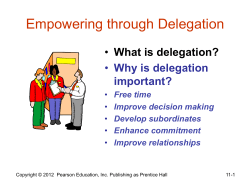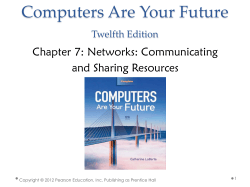
Chapter 4 Motivation and Global Values CONSUMER BEHAVIOR, 10e
Chapter 4 Motivation and Global Values CONSUMER BEHAVIOR, 10e Michael R. Solomon 4-1 Copyright © 2013 Pearson Education, Inc. publishing as Prentice Hall Learning Objectives When you finish this chapter, you should understand why: 1. It’s important for marketers to recognize that products can satisfy a range of consumer needs. 2. The way we evaluate and choose a product depends upon our degree of involvement with the product, the marketing message, and/or the purchase situation. Copyright © 2013 Pearson Education, Inc. publishing as Prentice Hall 4-2 Learning Objectives (continued) 3. Our deeply held cultural values dictate the types of products and services we seek out or avoid. 4. Consumers vary in the importance they attach to worldly possessions, and this orientation in turn has an impact on their priorities and behaviors. Copyright © 2013 Pearson Education, Inc. publishing as Prentice Hall 4-3 Learning Objectives (continued) 5. Products that succeed in one culture may fail in another if marketers fail to understand the differences among consumers in each place. 6. Western cultures have a huge impact around the world, although people in other countries don’t necessarily ascribe the same meanings to products we do. Copyright © 2013 Pearson Education, Inc. publishing as Prentice Hall 4-4 Learning Objective 1 • It is important for marketers to recognize that products can satisfy a range of consumer needs. Copyright © 2013 Pearson Education, Inc. publishing as Prentice Hall 4-5 Needs and Motivation • • • • Needs may be utilitarian or hedonic The desired end state is the goal The degree of arousal is drive Personal and cultural factors combine to create a want – one manifestation of a need • Motivation is described in terms of strength and direction Copyright © 2013 Pearson Education, Inc. publishing as Prentice Hall 4-6 Motivational Strength • Motivational strength: degree of willingness to expend energy to reach a goal • Drive theory: biological needs that produce unpleasant states of arousal (e.g., hunger) • Expectancy theory: behavior is pulled by expectations of achieving desirable outcomes Copyright © 2013 Pearson Education, Inc. publishing as Prentice Hall 4-7 What Do We Need? Biogenic Needs Psychogenic Needs Utilitarian Needs Hedonic Needs Copyright © 2013 Pearson Education, Inc. publishing as Prentice Hall 4-8 Motivational Conflicts • Goal valence (value): consumer will: • Approach positive goal • Avoid negative goal • Example: Partnership for a Drug-Free America communicates negative consequences of drug addiction for those tempted to start Copyright © 2013 Pearson Education, Inc. publishing as Prentice Hall 4-9 Figure 4.1 Types of Motivational Conflicts • Two desirable alternatives • Cognitive dissonance • Positive & negative aspects of desired product • Guilt of desire occurs • Facing a choice with two undesirable alternatives Copyright © 2013 Pearson Education, Inc. publishing as Prentice Hall 4-10 Specific Needs and Buying Behavior NEED FOR ACHIEVEMENT NEED FOR AFFILIATION Value personal accomplishment Want to be with other people Place a premium on products that signify success (luxury brands, technology products) Focus on products that are used in groups (alcoholic beverages, sports bars) NEED FOR POWER NEED FOR UNIQUENESS Control one’s environment Assert one’s individual identity Focus on products that allow them to have mastery over surroundings (muscle cars, loud boom-boxes) Enjoy products that focus on their unique character (perfumes, clothing) Copyright © 2013 Pearson Education, Inc. publishing as Prentice Hall 4-11 Levels of Needs in the Maslow Hierarchy Copyright © 2013 Pearson Education, Inc. publishing as Prentice Hall 4-12 For Reflection • Some studies show that an activity can satisfy every level of Maslow’s hierarchy. What does this say about the hierarchy? • • • • • I like to work in the soil (physiological) I feel safe in my garden (safety) I can share my produce with others (affiliation) I can create something of beauty (esteem) My garden gives me a sense of peace (selfactualization) Copyright © 2013 Pearson Education, Inc. publishing as Prentice Hall 4-13 Learning Objective 2 • The way we evaluate and choose a product depends upon our degree of involvement with the product, the marketing message, and/or the purchase situation. Copyright © 2013 Pearson Education, Inc. publishing as Prentice Hall 4-14 Consumer Involvement • Involvement: perceived relevance of an object based on one’s needs, values, and interests • We get attached to products: • “All in One” restaurant tattoo on consumer’s head • Lucky magazine for women who obsess over shopping • A man tried to marry his car when his fiancée dumped him Copyright © 2013 Pearson Education, Inc. publishing as Prentice Hall 4-15 Figure 4.3 Conceptualizing Involvement Copyright © 2013 Pearson Education, Inc. publishing as Prentice Hall 4-16 Levels of Involvement: From Inertia to Passion • Inertia is consumption at the low end of involvement; decisions made out of habit (lack of motivation) • Flow state occurs when consumers are truly involved • Sense of control • Concentration • Mental enjoyment • Distorted sense of time Copyright © 2013 Pearson Education, Inc. publishing as Prentice Hall 4-17 Table 4.1 Measuring Involvement To me (object to be judged) is: 1. important _:_:_:_:_:_:_ unimportant 2. boring _:_:_:_:_:_:_ interesting 3. relevant _:_:_:_:_:_:_ irrelevant 4. exciting _:_:_:_:_:_:_ unexciting 5. means nothing _:_:_:_:_:_:_ means a lot 6. appealing _:_:_:_:_:_:_ unappealing 7. fascinating _:_:_:_:_:_:_ mundane 8. worthless _:_:_:_:_:_:_ valuable 9. involving _:_:_:_:_:_:_ uninvolving 10. not needed _:_:_:_:_:_:_ needed Copyright © 2013 Pearson Education, Inc. publishing as Prentice Hall 4-18 Purchase Situation Involvement • Purchase situation involvement: differences that occur when buying the same object for different contexts. • Example: wedding gift • For boss: purchase expensive vase to show that you want to impress boss • For cousin you don’t like: purchase inexpensive vase to show you’re indifferent Copyright © 2013 Pearson Education, Inc. publishing as Prentice Hall 4-19 For Reflection • Describe your level of involvement with the “product” and devise some marketing opportunities to reach this group. Copyright © 2013 Pearson Education, Inc. publishing as Prentice Hall 4-20 Learning Objective 3 • Our deeply held cultural values dictate the types of products and services we seek out or avoid. Copyright © 2013 Pearson Education, Inc. publishing as Prentice Hall 4-21 Consumer Values • Value: a belief that some condition is preferable to its opposite • Example: looking younger is preferable to looking older • Products/services = help in attaining value-related goal • We seek others that share our values/ beliefs • Thus, we tend to be exposed to information that supports our beliefs Copyright © 2013 Pearson Education, Inc. publishing as Prentice Hall 4-22 Core Values • Core values: values shared within a culture • Enculturation: learning the beliefs and values of one’s own culture • Acculturation: learning the value system and behaviors of another culture Copyright © 2013 Pearson Education, Inc. publishing as Prentice Hall 4-23 For Reflection • What do you think are the three to five core values that best describe Americans today? • How are these core values relevant to the following product categories: • Cars? • Clothing? • Higher education? Copyright © 2013 Pearson Education, Inc. publishing as Prentice Hall 4-24 Learning Objectives 4 and 5 • Consumers vary in the importance they attach to worldly possessions, and this orientation in turn has an impact on their priorities and behaviors. • Products that succeed in one culture may fail in another if marketers fail to understand the differences among consumers in each place. Copyright © 2013 Pearson Education, Inc. publishing as Prentice Hall 4-25 Hofstede’s Cultural Dimensions • • • • • Power distance Individualism Masculinity Uncertainty avoidance Long-term orientation Copyright © 2013 Pearson Education, Inc. publishing as Prentice Hall 4-26 Table 4.2 Terminal and Instrumental Values Instrumental Value Terminal Value Ambitious A comfortable life Capable A sense of accomplishment Self-controlled Wisdom Copyright © 2013 Pearson Education, Inc. publishing as Prentice Hall 4-27 List of Values (LOV) • Identifies nine consumer segments based on values they endorse; and • Relates each value to differences in consumption behaviors • Example: those who endorse sense of belonging read Reader’s Digest and TV Guide drink and entertain more, and prefer group activities Copyright © 2013 Pearson Education, Inc. publishing as Prentice Hall 4-28 Means-End Chain Model • Very specific product attributes are linked at levels of increasing abstraction to terminal values • Alternative means to attain valued end states • Laddering technique uncovers consumers’ associations between specific attributes and general consequences Copyright © 2013 Pearson Education, Inc. publishing as Prentice Hall 4-29 Figure 4.4 Hierarchical Value Maps for Vegetable Oil in Three Countries Copyright © 2013 Pearson Education, Inc. publishing as Prentice Hall 4-30 Learning Objective 6 • Western cultures have a huge impact around the world, although people in other countries don’t necessarily ascribe the same meanings to products we do. Copyright © 2013 Pearson Education, Inc. publishing as Prentice Hall 4-31 Conscientious Consumerism • Conscientious consumerism is a focus on personal health merging with a growing interest in global health • LOHAS (lifestyles of health and sustainability) • Worry about the environment • Want products to be produced in a sustainable way Copyright © 2013 Pearson Education, Inc. publishing as Prentice Hall 4-32 Carbon Footprint Breakdown Copyright © 2013 Pearson Education, Inc. publishing as Prentice Hall 4-33 Materialism • Materialism: the importance people attach to worldly possessions • “The good life”...“He who dies with the most toys, wins” • Materialists: value possessions for their own status and appearance • Non-materialists: value possessions that connect them to other people or provide them with pleasure in using them Copyright © 2013 Pearson Education, Inc. publishing as Prentice Hall 4-34 Chapter Summary • Products address a wide range of consumer needs. • How we evaluate a product depends on our involvement with that product, the marketing message, and the purchase situation. • Our cultural values dictate the products we seek out and avoid. • Consumers vary in how important possessions are to them. Copyright © 2013 Pearson Education, Inc. publishing as Prentice Hall 4-35
© Copyright 2025




















